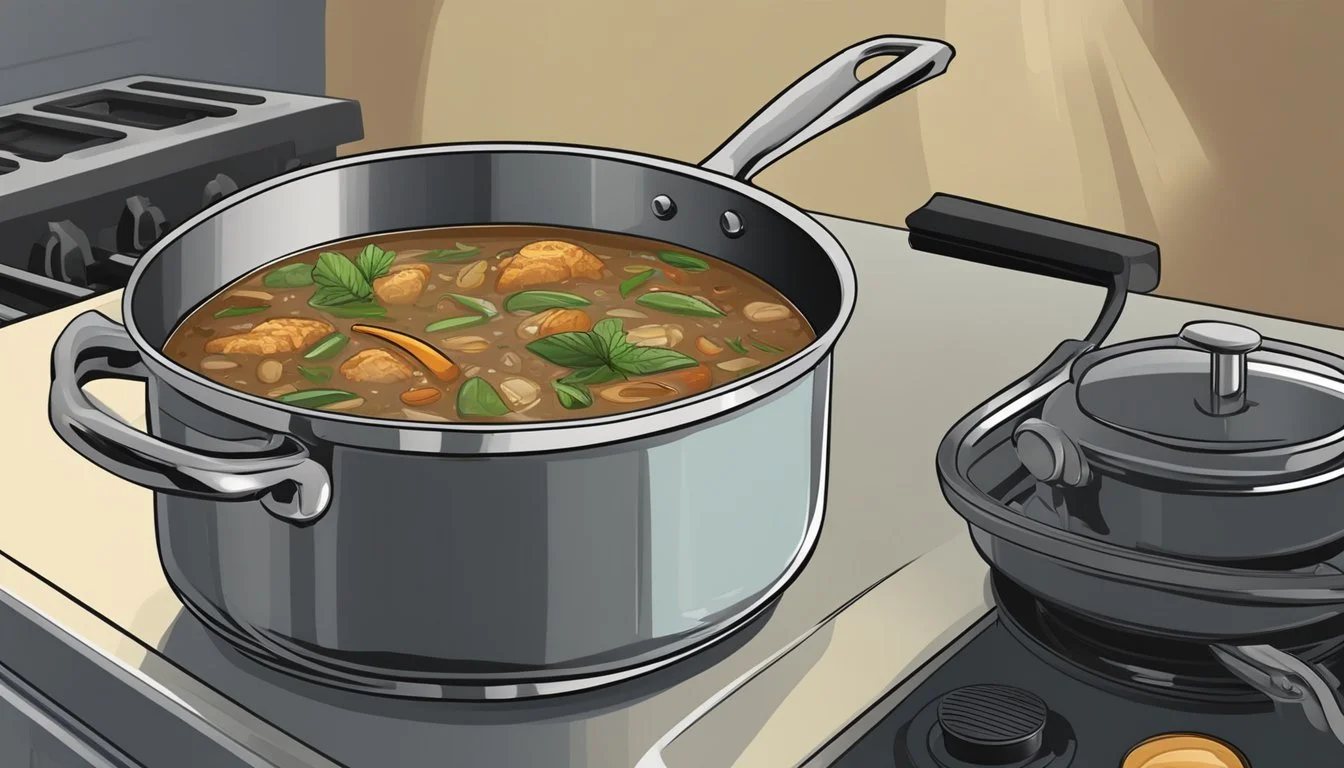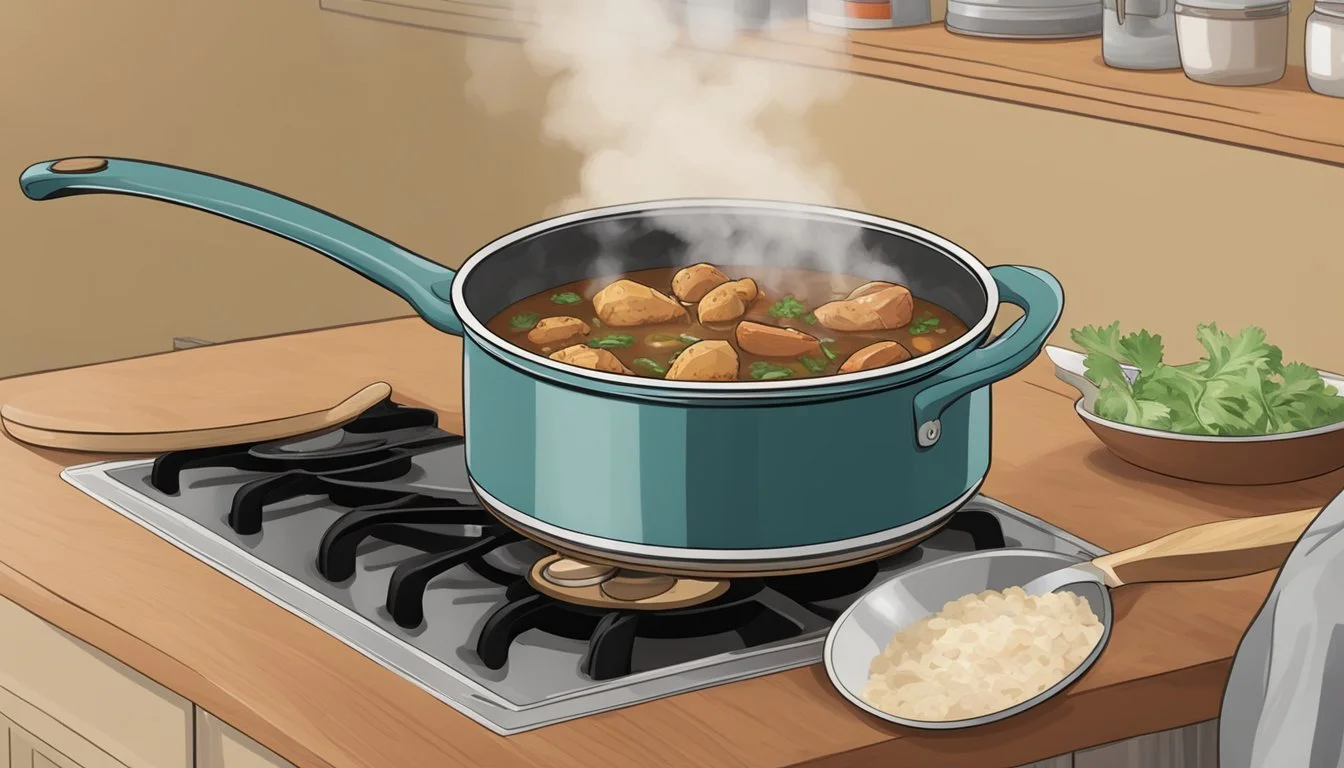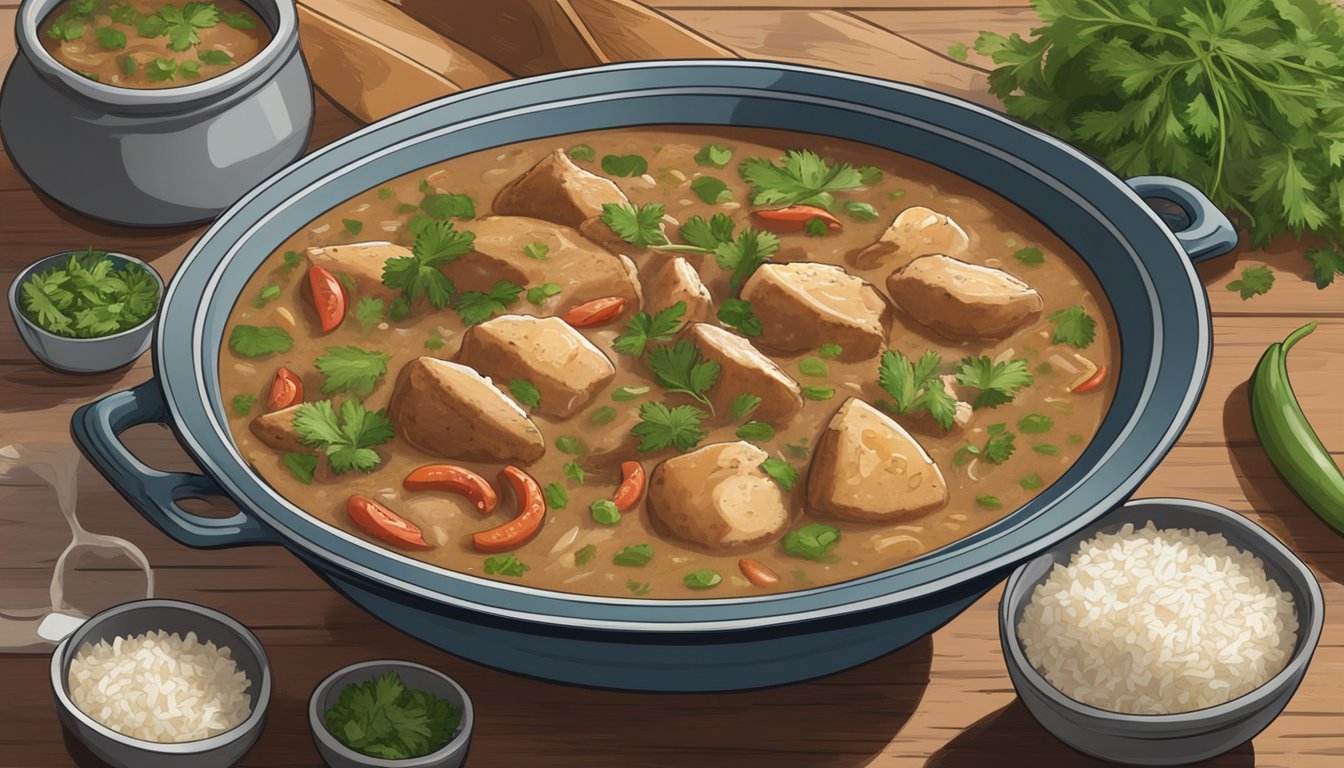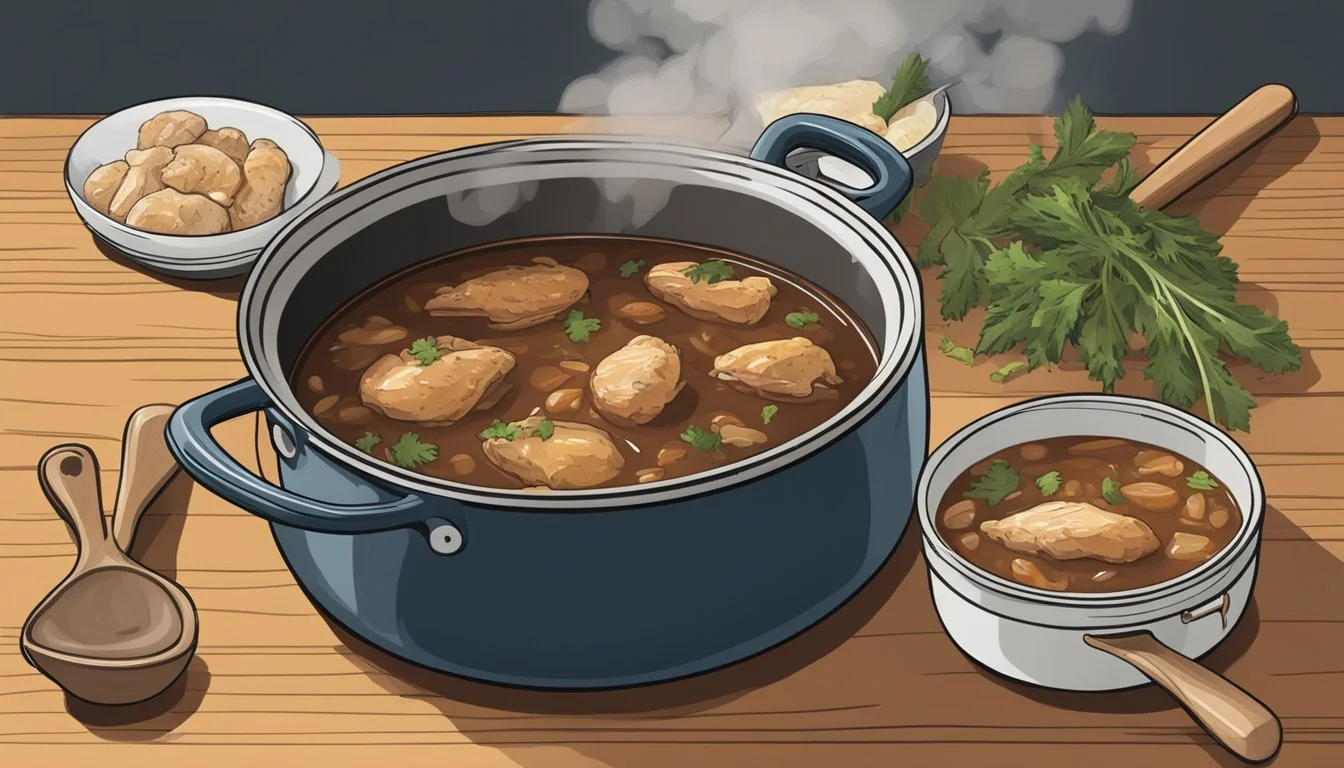How to Reheat Chicken and Andouille Gumbo
Expert Tips for Perfect Results
Reheating Chicken and Andouille Gumbo can be a delicate task. This beloved Cajun dish, with roots deep in the culinary traditions of New Orleans, deserves careful attention to preserve its rich flavors and textures.
To ensure your gumbo maintains its authentic Louisiana charm, use the stovetop method. Place the gumbo in a pot and heat it slowly at a low temperature, stirring occasionally to prevent sticking and distribute heat evenly. This technique helps retain the dish's comforting elements and allows the roux and spices to meld seamlessly.
For those in a hurry, the microwave presents a quicker alternative. Cover the gumbo with a microwave-safe cover and heat on medium power in one-minute intervals, stirring between each session. Ensuring the internal temperature reaches at least 165°F (74°C) will keep your gumbo safe to eat while preserving its hearty, Creole cuisine flavors.
Understanding Gumbo
Gumbo is a rich, flavorful stew deeply rooted in Louisiana culinary traditions. Key elements include the roux, the use of the "Holy Trinity" of vegetables, and various proteins like chicken and andouille sausage.
The Basics of Gumbo
Gumbo is a hearty dish known for its thick texture and deep flavor profile. It typically includes a combination of meat or seafood and vegetables. The "Holy Trinity"—a mix of onions, bell peppers, and celery—is fundamental to any gumbo recipe.
Chicken Gumbo and Seafood Gumbo are popular varieties, often seasoned with spices and herbs native to Louisiana. Gumbo is often served over rice, making it a filling and comforting meal.
The Importance of Roux
The roux is essential in gumbo, acting as a thickening agent and base for the stew. Made by cooking flour and fat (usually butter or oil), it ranges in color from light to dark brown. A dark roux provides a rich, nutty flavor and is crucial for authentic gumbo.
In Creole-style gumbos, the roux is typically lighter compared to Cajun-style. The slow-cooking process requires patience but significantly enhances the depth of the dish.
Variations: Cajun vs. Creole
Cajun and Creole gumbos differ in ingredients and preparation methods. Cajun Gumbo often uses a dark roux and focuses on simpler, rural ingredients reflecting its French and African influences. It frequently features chicken and andouille sausage.
Creole Gumbo incorporates tomatoes and sometimes okra, showing its Spanish and French influences. Seafood is common in Creole variations, highlighting the diversity of New Orleans cuisine. Understanding the differences helps in appreciating the nuances of each style.
Preparation Before Reheating
Proper preparation ensures that Chicken and Andouille Gumbo retains its rich flavor and smooth texture when reheated. Key aspects include proper storage and having the right tools at hand.
Storing Chicken and Andouille Gumbo
When dealing with leftovers, particularly those containing rotisserie chicken or seafood, proper storage is crucial. Always allow the gumbo to cool to room temperature before transferring it to an airtight container. Refrigerate promptly to maintain freshness.
For refrigeration:
Use tight-lidded containers to prevent contamination.
Consume within 3-4 days.
For freezing:
Portion the gumbo into freezer-safe containers.
Leave some space at the top for expansion.
Label with dates to track storage time.
Thick gumbo with a well-prepared roux and thickener handles freezing well, preserving its hearty texture upon reheating.
Tools and Equipment Needed for Reheating
Different reheating methods require specific tools. The stovetop method necessitates a suitable pot or pan, preferably with a heavy base for even heat distribution.
For stovetop reheating:
A pot
A spoon for stirring
For microwave reheating:
Microwave-safe containers
Covers or microwave-safe lids
A thermometer to check internal temperature
Ensuring gumbo and side dishes, like rice, are reheated separately can help maintain their individual textures. Using the right tools aids in evenly reheating gumbo without compromising its flavor or consistency.
Reheating Techniques
Reheating chicken and andouille sausage gumbo requires careful attention to maintain its texture and flavor. Below are various methods for reheating this flavorful stew effectively.
Stovetop Reheating Method
The stovetop method helps preserve the rich flavors and textures of gumbo. Begin by placing the gumbo in a pot or Dutch oven. Heat it over medium-low heat.
Stir frequently to prevent the roux-based broth from sticking to the bottom. Allow the gumbo to simmer gently, which ensures even reheating. A slow, steady simmering helps maintain the stew’s consistency without separating the roux.
Monitor the temperature with a food thermometer. The gumbo should reach an internal temperature of at least 165°F (74°C) before serving.
Oven Reheating Method
Using an oven for reheating is ideal for large quantities. Preheat the oven to 350°F (175°C). Transfer the gumbo to an oven-safe dish.
Cover the dish with aluminum foil to retain moisture. This prevents the gumbo from drying out. Place the covered dish in the oven and bake for 20-30 minutes.
Stir halfway through the heating process to ensure even distribution of heat. The gumbo is ready when it reaches an internal temperature of 165°F (74°C).
Microwave Reheating Method
For convenience, the microwave is a good option. Transfer the gumbo to a microwave-safe bowl. Cover it with a microwave-safe lid or plastic wrap that has holes to vent steam.
Heat on medium power to avoid overheating, in one-minute intervals. Stir the gumbo between each interval. This technique helps distribute the heat evenly and prevents hot spots.
Check the internal temperature to ensure it has reached 165°F (74°C). Adjust the heating time as necessary, depending on the quantity.
Slow Cooker Reheating Method
A slow cooker or crockpot works excellently for reheating gumbo without losing its essence. Set the slow cooker to low heat.
Transfer the gumbo into the slow cooker and cover with the lid. Allow it to heat slowly over 2-3 hours. Stir occasionally to prevent sticking and ensure even heating.
This method preserves the taste and texture while thoroughly heating. The slow process helps maintain the stew-like consistency that is characteristic of gumbo. Ensure the internal temperature reaches at least 165°F (74°C) before serving.
Preserving the Flavors and Textures
Reheating chicken and andouille gumbo while maintaining its rich flavors and textures requires careful attention to seasonings and the addition of fresh ingredients for balance.
Managing Seasonings
When reheating gumbo, consider reinforcing the seasonings. The flavors can become muted, so adding a bit more Cajun seasoning, salt, or black pepper may help. Garlic powder and onion powder can also enhance the overall taste.
Including two or three fresh bay leaves during the reheating process will intensify the aroma. Thyme and a pinch of cayenne pepper can elevate the spice profile. Gumbo file powder, added sparingly at the end, can thicken the gumbo and contribute to its unique flavor.
Always taste the gumbo before serving to ensure a well-balanced flavor profile. Adjust the spices as needed, but avoid making it overly salty or spicy.
Adding Freshness and Balance
To maintain balance, introduce new ingredients after reheating. Fresh herbs like chopped parsley add a burst of freshness. A dash of hot sauce can sharpen and lift the flavors. Incorporate a handful of chopped scallions or green onions for added texture and slight pungency.
If the gumbo is served with rice, reheat the rice separately to avoid a gummy texture. Fluffing it with a fork ensures it remains light and complements the gumbo well.
Consider squeezing a bit of lemon juice to brighten the dish. The acidity can cut through any heaviness, making the gumbo taste just as vibrant as when it was first made.
Serving Recommendations
Enjoying Chicken and Andouille Gumbo is not complete without appropriate sides and last-minute additions. These elements enhance the dish, bringing out its depth of flavor.
Proper Accompaniments
Rice: Steamed white rice is a classic choice. The neutral flavor of the rice balances the rich, spicy gumbo. Place a scoop of rice in the center of the bowl before ladling the gumbo over it.
Cornbread: A piece of cornbread on the side adds a slightly sweet contrast to the savory gumbo and provides a hearty texture that complements the dish well.
Hot Sauce: Various hot sauces allow guests to adjust the heat level to their preference. Leave a few options on the table.
Final Touches Before Serving
Green Onions and Scallions: Sprinkle finely chopped green onions or scallions over the gumbo. This adds a fresh, crisp element that brightens the rich flavors.
Parsley: Chopped parsley provides a pop of color and a subtle herby note, enhancing the gumbo's presentation and taste.
Filé Powder: Offer filé powder on the side for those who love its distinctive, earthy flavor. A small sprinkle is enough to add complexity to each bite.
Safety Tips
Proper Storage: After preparing chicken and andouille gumbo, it should be cooled before storing. Transfer the gumbo to an airtight container. Place the container in the refrigerator within two hours of cooking. Gumbo can be stored in the fridge for 4-5 days.
Refrigeration: Ensure the refrigerator temperature is set at or below 40°F (4°C). This prevents bacterial growth in chicken and sausage.
Freezing Tips: For longer storage, freeze the gumbo. Use freezer-safe containers or heavy-duty freezer bags. Label with the date and contents. Frozen gumbo can be stored for up to 3 months.
Thawing: When ready to reheat, thaw frozen gumbo in the refrigerator overnight. Never thaw gumbo at room temperature as this can encourage bacterial growth.
Reheating Guidelines: To reheat in the microwave, place gumbo in a microwave-safe container. Cover with a microwave-safe lid or vented plastic wrap. Heat on medium power in 30-second bursts, stirring in between, until it reaches an internal temperature of 165°F (74°C).
Stove Method: Reheat on the stovetop by placing the gumbo in a pot. Heat on medium-low, stirring occasionally to ensure even heating. Ensure it reaches 165°F throughout.
Monitoring Temperature: Use a food thermometer to check the internal temperature. It’s essential that the gumbo reaches at least 165°F (74°C) before consumption.
Avoid Cross-Contamination: Use clean utensils and containers. Separate gumbo from raw foods to prevent cross-contamination.
By following these safety tips, foodborne illnesses can be prevented while enjoying leftovers.
Troubleshooting Common Issues
Gumbo enthusiasts often face challenges related to consistency and flavors when reheating their dish. Addressing these can help restore your gumbo to its original glory.
Adjusting Gumbo Consistency
One common issue is thickness. Gumbo should have a balanced, hearty consistency. If it becomes too thick, add a small amount of chicken broth or water. Stir well to ensure the liquid blends smoothly with the other ingredients.
Thickeners like roux or all-purpose flour are crucial. If your gumbo seems too thin, mix a little all-purpose flour with some warm water to form a slurry. Gradually add this to your gumbo while stirring constantly. Filé powder can also be used; sprinkle it over the gumbo and stir to thicken.
Be mindful of the amount of thickener. Too much can make your gumbo pasty. Start with small amounts, adjusting as needed to achieve the desired consistency.
Reviving Flavors
Reheating gumbo may sometimes result in diminished flavors. To revive flavors, consider adding fresh seasonings. A dash of Cajun seasoning, salt, or freshly ground black pepper can do wonders.
Vegetables such as bell peppers, onions, and celery, known as the "holy trinity" in Cajun cooking, may need refreshing. Sauté a small portion of these vegetables and add them to your gumbo.
Your meats like chicken and andouille sausage might require additional seasoning. Gently warm them separately and incorporate back into the gumbo, enhancing the taste. Also, adding a few drops of hot sauce can provide a flavor boost without overpowering the dish.
Overall, a careful approach to adjusting consistency and flavors will ensure your reheated gumbo tastes just as delicious as when it was first made.







